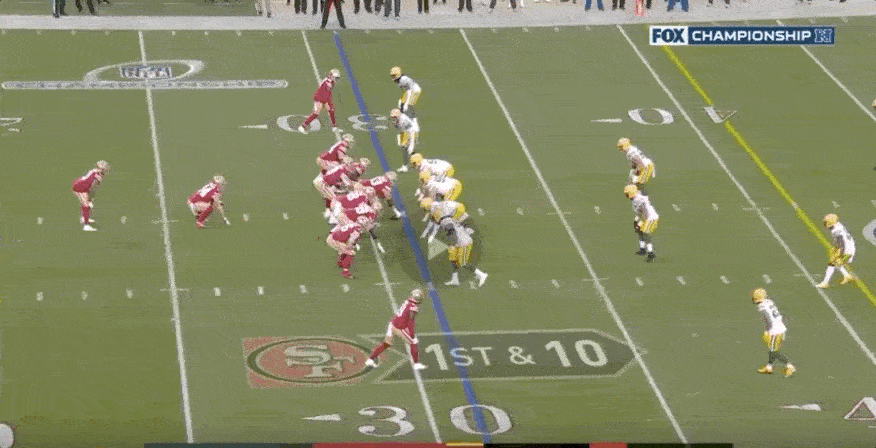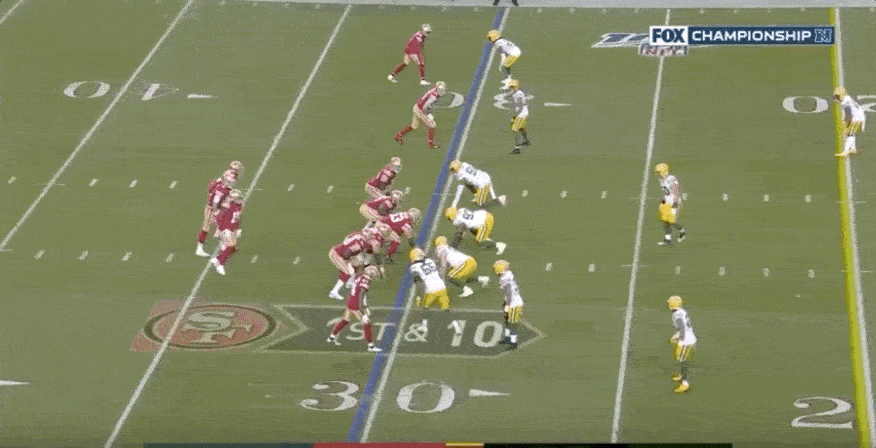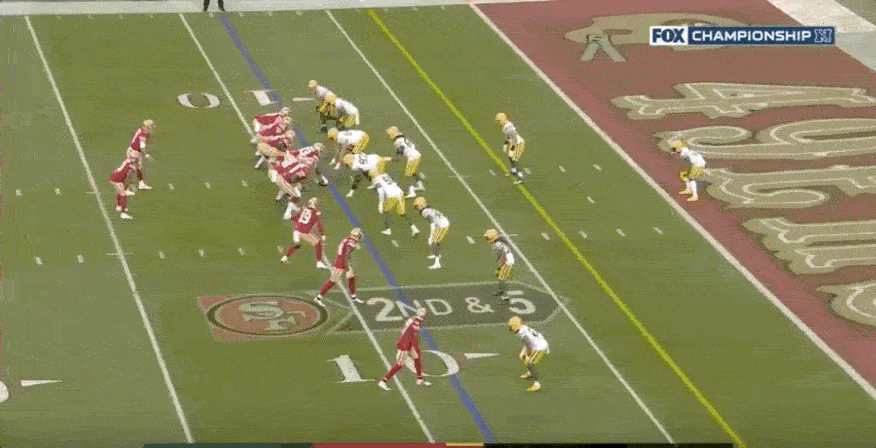The Shanahan O is probably one of the more poorly examined and least understood offensive systems in football. It doesn’t even really have a name other than the general “zone run game” tag that isn’t always particularly useful since a lot of teams run zone but don’t run the offense developed by Mike Shanahan.
The Sean McVay offense, for all the excitement it engendered a year ago and all the assistants that it yielded promotions for, was essentially just the Shanahan offense with some modern tweaks and complements. The offense that sprung RG3 in Washington to one good season in which he won “Rookie of the year” with 3200 passing yards and 815 rushing yards got people excited for its use of QB-read schemes, but of course it too was the Shanahan offense (coached by papa and son Kyle).
The Seattle Seahawks offense that made use of Russell Wilson’s legs and Marshawn Lynch’s savage running was essentially the Shanahan O as well. Everyone got frustrated with the Seahawks emphasis on the run this year even though their best hope in a given game was Russell Wilson throwing and improvising, but the structure of their system hinges on zone runs and play-action.
This San Francisco 49ers offense that has propelled the team to a 13-3 season with convincing postseason wins over Minnesota (27-10) and Green Bay (37-20) is still the Shanahan offense, now totally overseen by son Kyle.
The foundation of this offense is the “wide zone” running play, perfected by former Denver OL coach Alex Gibbs. Wide or outside zone is the primary pressure point the offense puts on defenses and then Kyle Shanahan in particular has a million ways to boost the play and then punish you for how you overplay it.
Legacy mode
You can find film of Alex Gibbs presenting for a couple of hours to the Urban Meyer Florida offensive staff on his outside zone scheme if you look for it on YouTube. One dimension to the scheme that he’s explaining is that playing 11 personnel had been found to be the best way to run the wide zone play because it spread the defense out and made it easier to crease them with cutbacks.
Well defenses have adjusted since then and linebackers are a lot quicker, so those 11 personnel wide zone plays can be harder to get right when the OL have to secure the line of scrimmage and then go pick off <4.6 LBs in space. That’s one reason why one of the more important players on the 49er roster is their fullback, Kyle Jusczyzk:

San Francisco is sorta old school in that they use a lot of 21 personnel and you can see the benefit they get from that here by watching the blocking angles for RT Mike McGlinchey and Jusczyck. McGlinchey doesn’t have to try and reach the play side LB, that job goes to the FB. They still get a lot of the desired horizontal stress because TE George Kittle is not only their top target in the passing game but a great blocker who rides the OLB out towards the sideline and opens the crease.
Kittle is one of a few Iowa products who has hilariously boosted his NFL team considerably moreso than he did his college program. The Hawkeyes under Kirk Ferentz run something similar to the Shanahan offense with TEs and FBs working in concert with locally grown OL to secure paths on outside zone for the 3-star RBs they recruit. They do a fantastic job of identifying and developing athletic TEs as blockers only for the NFL to make far greater use of their receiving ability than did the Hawkeyes. It works out much better for the pros than Iowa, I’m not sure what Ferentz is getting out of it but he remains employed along with his son so I guess everyone is making out okay.
The Kyle Shanahan 49ers are a bit of a departure from the old school, Gibbs teams though in that he preferred to major in outside zone, minor in inside zone, and forego electives. This team mixes in considerably more scheme with traps and power runs that take advantage of the superior blocking and versatility of Kittle and Jusczyck. But they’ve also turned heads with their creative ways of running the standard schemes and making the most of their personnel, such as:

This is basically a college play, even though it’s still wide zone at heart. Deebo Samuel motions in like a RB only to flare back out to be a target for a bubble screen on the perimeter, where Kittle is flexed out to serve as a blocker. The Packers struggle to adjust to the formation and the motion, partly because they have a blitz on, and they aren’t able to get anyone into the cutback lane.
The 49ers have tons and tons of sweeps and motions they incorporate ALL the time to change defenses’ assignments rapidly before the snap and help create angles and hesitation that leads to creases that leads to track star Raheem Mostert running free through your defense. I’ll clip one more play from the decimation of the Packer D that reveals the creativity at play in this scheme:

We gotta draw this one up to really see everything that’s going on.

They have Deebo in the slot in the sort of position that would suggest to the defense in college that he’s running a bubble screen opposite an outside zone run to the boundary, much like our previous clip. The Packers are playing man coverage in a 46-ish front with big OLBs on either perimeter to try and keep the ball contained and then another one over the center at will (6-4, 272 pound Za’Darius Smith). I think they blew this one, assignment wise, because the sam linebacker Kyler Fackrell spilled the pulling guard when he should have been doing all he could to contain the sweep by Deebo since he had no real help outside.
As it happens though, Deebo wasn’t receiving the ball on a sweep, he was playing the role of a freaking fullback on a counter run. The guard pulled and sealed the edge player while Deebo lead around. The way the Packers were condensed between the tackles meant virtually zero pursuit and the free safety had to fly down to try and play it only to get buried by the 5-11/214 pound Samuel while the RB glides in for a score.
I bet Lincoln Riley watched that one from his home in Norman and started jotting down some notes. Like on many plays from this game, the Packer defensive staff will probably stew on that one for a while because they played it so poorly and with a ridiculous package.
Monkey-wrenching the Shanahan system
This 49er O isn’t as vulnerable to getting monkey-wrenched as the McVay offense from a year ago. I figured last year that the way in which the 2018 LA Rams’ offense closely tied play-action pass to their wide zone play meant that should Bill Belichik figure out how to stop or slow the run up front without overplaying it with his secondary that the entire system would fall apart.
Sure enough, Belichik found the right gear to toss the wrench into and McVay’s offense unraveled. He’d done something similar to the Seahawks in a previous Super Bowl. In both games the Patriots essentially played something akin to the 46 defense with five defenders on the OL covering up every OL while a single, ultra-savvy ILB was primarily responsible for tracking the RB and closing the crease while playing largely free of blocks because of the protection up front.
If you can play this offense without resorting to playing a zone that can be easily manipulated by their play-action game then you’re in good shape. The problem teams have had thus far is that the 49ers have a more versatile run game than just the outside zone scheme beyond also having a dozen ways to execute and disguise their various run plays.
Because of the speed of the personnel for the 49ers and the horizontal stress that they get with Deebo, the PA game, and the wide zone system I think the Packers were at least right to weight the edges with OLBs playing contain.
The right answer for the Chiefs is probably just to borrow from college, or from the Titans’ solution for the Ravens’ power-option O, and utilize quarters coverage.
If you play contain with the edge players and give the safeties a chance to run the alleys based off how the inside receivers respond you can keep the ball funneled into a narrower range and have your LBs play fast because the safeties are coming hard behind them. In man coverage the safeties have to rotate a lot and spin back and forth, you’re less vulnerable to these motions and strength of call changes playing in quarters.
The best practices for punishing quarters safeties typically involve RPOs that are illegal in the NFL and spread play-action that is more quick-hitting than the Shanahan system. The trouble this offense has with quarters is that it’s harder to reach and crease the LBs because they can play fast within a narrower confine and then even when you do the safeties tend to clean up before you do much damage. The single-high defenses that NFL teams prefer often get into trouble because the overhangs get cleared out by routes and the safeties get put into too much space.
The Big 12 Chiefs vs Shanahan’s legacy
The Kansas City Chiefs have two obvious plays in this game. One is to try and take away the run game (ideally with quarters but I don’t know what all is in their playbook). If they can make Jimmy Garappolo have to beat them by reading their D and making good throws on passing downs like the Rams’ Jared Goff did a year ago they’ll be in good shape.
The other is to try and stop the run with Patrick Mahomes. Incidentally, that also plays into their best chance against the San Franciso defense.
The 49ers did some real damage this season with a “wide-9” defensive alignment that paired Nick Bosa and Dee Ford as 9-technique defensive ends that would line up way outside and abuse opponents on the perimeter with their speed. Bosa had nine sacks and Ford had 6.5 while they also were able to contain the ball inside for their ultra-disruptive DTs, DeForest Buckner (7.5) and Arik Armstead (10 sacks). Both of those guys are really long at 6-7 apiece and both were 4i-techniques for the Oregon Ducks in a 3-4 defense.
San Francisco is uniquely equipped to handle Mahomes in the same way that the recently retired Eli Manning NY Giants were able to beat the Tom Brady Patriots on two occasions. Inside pass-rush from a four-down front. In both of those games the Giants often played with three DE fronts that moved Justin Tuck to DE while playing speedy rushers at both outside spots. That allowed them to get quick, and particularly inside, pressure on Brady and the Patriots while leaving seven in coverage, which undid the New England passing game.
The 49ers present similar problems due to the superiority of their DL lineups that put those four on the field together. The Chiefs have two counters, both of which also serve them against the San Fran offense, one is Mahomes’ scrambling ability and the other is to make this a wide open, up tempo game where each team has as many possessions as possible.
That 49er DL isn’t going to be able to get after Mahomes all night if he’s throwing it 40-50 times and scrambling 10 more times. They’ll tire and potentially be unavailable to make stops during crucial fourth quarter possessions. The strategy of running the ball and controlling the clock is a loser against the 49ers, they can still up the number of possessions by moving fast when they do have the ball and their style and potency allows them to erase the sorts of deficits of the size that ball control, rushing attacks tend to create.
San Francisco’s use of hybrid personnel and run/pass balance is exceptionally potent and makes them perhaps the best version of a run-centric pro offense. However, I expect the spread passing trump card to be played and produce another victory.
********
Buy my book to read about Pat Mahomes’ humble beginnings in the Big 12 conference, where this up-tempo, spread passing style has long developed and plotted its expansion across the rest of football.

Great content per usual. Thanks Ian.
Super Bowl score prediction?
Super Bowl LIV: Strategy beats tactics – Concerning Sports
[…] challenge of that system, as I outlined in my preview, is what happens when a team can either match up honestly and stop your run or pass game, or what […]